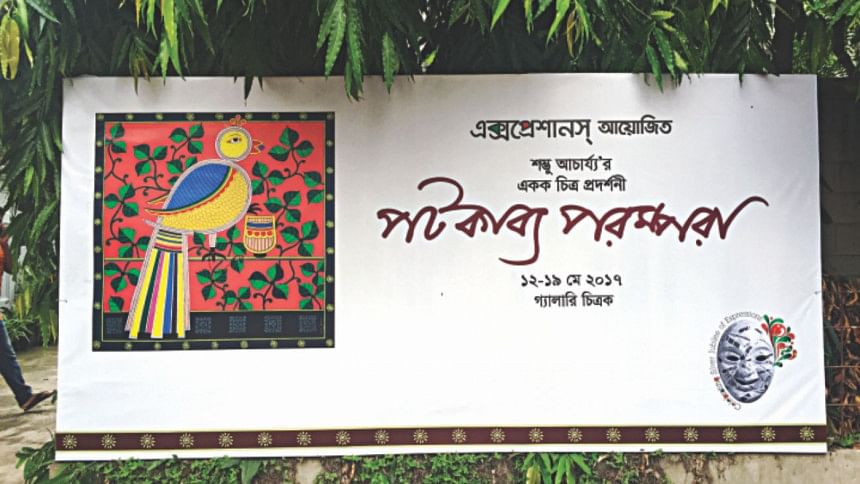The Scrolls and Song of Gazi Pir

In a country with scant patronization of the folk arts, eminent thespian Ramendu Majumdar's Expressions Ltd is to be congratulated for organizing 'Patakabbo Parampara', a week-long exhibition of the folk painter Shambhu Acharya's 'patachitra' or 'scroll paintings' and more, from May 12 – 19, 2017 at the Chitrak Art Gallery, as part of the organization's Silver Jubilee celebrations. As Acharya is the ninth generation of patuas, or scroll artistes, who present paeans of the incredible tiger-riding Sufi saint Gazi through their artwork, it is apt that the exhibition concluded with a presentation of 'Gajir Gaan' by folk singers Mongol Mia and his uncle Waj Ali from Matlab in Chandpur. These songs, sung along with the scrolls, are ballads about the mythological Gazi Pir, recognized as a rival of Daksin Ray, the god of tigers.
Remarkably, it was Expressions, too, that had arranged Acharya's first solo exhibition in Dhaka in 2003. Since then he has gone on to be exhibited in cities the world over, including London, New York, Brussels. His work has found place within the collections of the British Museum in London, the Fukuoka Museum in Japan, the Shanghai Museum in China and many more.
Patuas traditionally worked by traveling from village to village with paintings of epic stories done on scrolls. In each village, they would sing songs narrating the stories on the canvas while unfurling their work at the same time, creating a dynamic oral tradition enhanced by visual art. Often a family or individual singer had a single pat that they would perform. Though the stories that were painted were repeated from artist to artist, each singer wrote their own melody to create a signature style.
Traditionally, all of the patuas' paints were handmade from naturally occurring sources such as indigo, tumeric and other plants. Many rural patuas, including Shambhu Acharya, continue to make their own paints to this day.
Of much interest is the performative transition being effected within such folk cultural practices. Fascinatingly, we notice a suspension of the categorical distinctions of tradition and modernity; and instead notice a shifting aesthetics of discursive signification wherein neither tradition nor modernity are ever made wholly present. This is very evident in Shambhu Acharya's work too, that embraces contents of contemporary context without totally moving away from the original form of an art handed down through generations. Cultural identities, thus, are considered to be performative constructs rather than actual essences in the face of spatial and temporal shifts in social relationships and sites of activity.
Gajir Gaan, or the 'Songs of Gazi', correspondingly, represents a theatre of intersections: historical, literary, and spiritual. Time and space collide and merge fluidly as the natural and supernatural worlds traverse dimensional barriers, flowing into one another and placing contemporary human characters into intimate contact with phantasmic specters of the past, both legendary and imaginary. These songs are part of the 'Panchali' literature, a genre of narrative folk songs. The word, 'panchali', originates from pauchal or pauchalika, meaning puppet.
Gazi songs are preceded by a bandana or hymn, sung by the main singer in which both Allah and Hindu Gods and Goddesses are invoked. The singer then narrates the story of Gazi's birth, his wars with the demons and the evil spirits, as well as his rescue of a merchant at sea. Although Gazi Pir was a Muslim, his followers included people from other religious communities as well.
These folk performances are ritual in nature and believed to be efficacious, with their performance having the ability to grant the wishes of those who make a 'manot', or vow, to arrange these performances.
'Panchali' Literature while embracing a stylistic formality, using dense literary allusion, and transgressive supernaturalism, comments upon the spiritual hunger of the modern world, and doing so mythologizes the present moment. While, there have been a few experiments to assimilate this aesthetics within contemporary literature, especially in the work of Salim Al Deen and Saymon Zakeria, more or less the genres remain popular, merely, with folk theatre. Folk theatre, on the hand, continues to keep, the mostly oral, 'Panchali' texts contextual and contemporary by incorporating issues of present day significance.
One hopes that young playwrights will delve deep into these liminal art forms, which exploit the permeable boundaries between the tangible and intangible that occur at a metaphysical junction between entertainment and religious rituals, because, without doubt patachitras and 'panchali' literature are invaluable cultural heritages of Bangladesh.

 For all latest news, follow The Daily Star's Google News channel.
For all latest news, follow The Daily Star's Google News channel. 



Comments